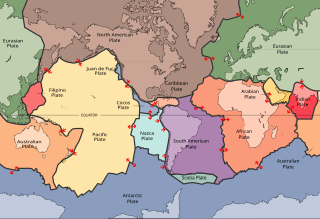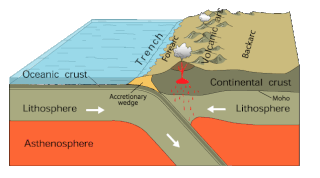Related Research Articles

Plate tectonics is the scientific theory that Earth's lithosphere comprises a number of large tectonic plates which have been slowly moving since about 3.4 billion years ago. The model builds on the concept of continental drift, an idea developed during the first decades of the 20th century. Plate tectonics came to be accepted by geoscientists after seafloor spreading was validated in the mid-to-late 1960s.

Geophysics is a subject of natural science concerned with the physical processes and physical properties of the Earth and its surrounding space environment, and the use of quantitative methods for their analysis. Geophysicists, who usually study geophysics, physics, or one of the earth sciences at the graduate level, complete investigations across a wide range of scientific disciplines. The term geophysics classically refers to solid earth applications: Earth's shape; its gravitational, magnetic fields, and electromagnetic fields ; its internal structure and composition; its dynamics and their surface expression in plate tectonics, the generation of magmas, volcanism and rock formation. However, modern geophysics organizations and pure scientists use a broader definition that includes the water cycle including snow and ice; fluid dynamics of the oceans and the atmosphere; electricity and magnetism in the ionosphere and magnetosphere and solar-terrestrial physics; and analogous problems associated with the Moon and other planets.

A lithosphere is the rigid, outermost rocky shell of a terrestrial planet or natural satellite. On Earth, it is composed of the crust and the lithospheric mantle, the topmost portion of the upper mantle that behaves elastically on time scales of up to thousands of years or more. The crust and upper mantle are distinguished on the basis of chemistry and mineralogy.

Subduction is a geological process in which the oceanic lithosphere and some continental lithosphere is recycled into the Earth's mantle at convergent boundaries. Where the oceanic lithosphere of a tectonic plate converges with the less dense lithosphere of a second plate, the heavier plate dives beneath the second plate and sinks into the mantle. A region where this process occurs is known as a subduction zone, and its surface expression is known as an arc-trench complex. The process of subduction has created most of the Earth's continental crust. Rates of subduction are typically measured in centimeters per year, with rates of convergence as high as 11 cm/year.

Forearc is a plate tectonic term referring to a region in a subduction zone between an oceanic trench and the associated volcanic arc. Forearc regions are present along convergent margins and eponymously form 'in front of' the volcanic arcs that are characteristic of convergent plate margins. A back-arc region is the companion region behind the volcanic arc.
A slow earthquake is a discontinuous, earthquake-like event that releases energy over a period of hours to months, rather than the seconds to minutes characteristic of a typical earthquake. First detected using long term strain measurements, most slow earthquakes now appear to be accompanied by fluid flow and related tremor, which can be detected and approximately located using seismometer data filtered appropriately. That is, they are quiet compared to a regular earthquake, but not "silent" as described in the past.

Geodynamics is a subfield of geophysics dealing with dynamics of the Earth. It applies physics, chemistry and mathematics to the understanding of how mantle convection leads to plate tectonics and geologic phenomena such as seafloor spreading, mountain building, volcanoes, earthquakes, faulting. It also attempts to probe the internal activity by measuring magnetic fields, gravity, and seismic waves, as well as the mineralogy of rocks and their isotopic composition. Methods of geodynamics are also applied to exploration of other planets.
Episodic tremor and slip (ETS) is a seismological phenomenon observed in some subduction zones that is characterized by non-earthquake seismic rumbling, or tremor, and slow slip along the plate interface. Slow slip events are distinguished from earthquakes by their propagation speed and focus. In slow slip events, there is an apparent reversal of crustal motion, although the fault motion remains consistent with the direction of subduction. ETS events themselves are imperceptible to human beings and do not cause damage.

The Shetland Plate, or South Shetland Plate, is a tectonic microplate located off the tip of the Antarctic Peninsula that contains the South Shetland Islands. The plate is bordered on three sides by the Antarctic Plate, while the fourth side is bordered by the Scotia Plate. The northwestern border is defined by the South Shetland Trench, separating the Shetland Plate to the south from the Antarctic Plate to the north. This trench is the remnant of a subduction zone where the defunct Phoenix Plate, now part of the Antarctic Plate, subducted under the Antarctic Peninsula and the Shetland Islands. The southeastern border is a rift zone, with the Antarctic Plate creating the Bransfield Basin. The southwestern and northeastern boundaries are each part of larger fracture zones. The southwestern border is the Hero Fracture Zone and separates the Antarctic Plate to the southwest from the Shetland Plate to the northeast. The northeastern boundary is the Shackleton Fracture Zone and separates the Shetland Plate to the southwest from the Scotia Plate.

In geology, the slab is a significant constituent of subduction zones.

Flat slab subduction is characterized by a low subduction angle beyond the seismogenic layer and a resumption of normal subduction far from the trench. A slab refers to the subducting lower plate. A broader definition of flat slab subduction includes any shallowly dipping lower plate, as in western Mexico. Flat slab subduction is associated with the pinching out of the asthenosphere, an inland migration of arc magmatism, and an eventual cessation of arc magmatism. The coupling of the flat slab to the upper plate is thought to change the style of deformation occurring on the upper plate's surface and form basement-cored uplifts like the Rocky Mountains. The flat slab also may hydrate the lower continental lithosphere and be involved in the formation of economically important ore deposits. During the subduction, a flat slab itself may deform or buckle, causing sedimentary hiatus in marine sediments on the slab. The failure of a flat slab is associated with ignimbritic volcanism and the reverse migration of arc volcanism. Multiple working hypotheses about the cause of flat slabs are subduction of thick, buoyant oceanic crust (15–20 km) and trench rollback accompanying a rapidly overriding upper plate and enhanced trench suction. The west coast of South America has two of the largest flat slab subduction zones. Flat slab subduction is occurring at 10% of subduction zones.

Subduction polarity reversal is a geologic process in which two converging plates switch roles: The over-lying plate becomes the down-going plate, and vice versa. There are two basic units which make up a subduction zone. This consists of an overriding plate and the subduction plate. Two plates move towards each other due to tectonic forces. The overriding plate will be on the top of the subducting plate. This type of tectonic interaction is found at many plate boundaries.
Maureen D. Long is an observational seismologist studying mantle and Mesosphere dynamics. She currently serves as a professor at Yale University within the Department of Geology and Geophysics.
Alik Ismail-Zadeh is a mathematical geophysicist known for his contribution to computational geodynamics and natural hazard studies, pioneering work on data assimilation in geodynamics as well as for outstanding service to the Earth and space science community. He is Senior Research Fellow at the Karlsruhe Institute of Technology in Germany.
Ridge push is a proposed driving force for plate motion in plate tectonics that occurs at mid-ocean ridges as the result of the rigid lithosphere sliding down the hot, raised asthenosphere below mid-ocean ridges. Although it is called ridge push, the term is somewhat misleading; it is actually a body force that acts throughout an ocean plate, not just at the ridge, as a result of gravitational pull. The name comes from earlier models of plate tectonics in which ridge push was primarily ascribed to upwelling magma at mid-ocean ridges pushing or wedging the plates apart.

Kevin C. A. Burke was a geologist known for his contributions in the theory of plate tectonics. In the course of his life, Burke held multiple professorships, most recent of which (1983-2018) was the position of professor of geology and tectonics at the Department of Earth and Atmospheric Science, University of Houston. His studies on plate tectonics, deep mantle processes, sedimentology, erosion, soil formation and other topics extended over several decades and influenced multiple generations of geologists and geophysicists around the world.
Karen Fischer is an American seismologist known for her research on the structure of Earth's mantle, its lithosphere, and how subduction zones change over geologic history.
Suzanne Carbotte is a marine geophysicist known for her research on the formation of new oceanic crust.

Oblique subduction is a form of subduction for which the convergence direction differs from 90° to the plate boundary. Most convergent boundaries involve oblique subduction, particularly in the Ring of Fire including the Ryukyu, Aleutian, Central America and Chile subduction zones. In general, the obliquity angle is between 15° and 30°. Subduction zones with high obliquity angles include Sunda trench and Ryukyu arc.
Susan Marian Ellis is a geophysicist based in New Zealand, who specialises in modelling the geodynamics of the Earth's crust deformation, at different scales. Ellis is a principal scientist at GNS Science and her main interests are in subduction, seismology, tectonics, crust and petrology. Ellis's current work focuses on the influence of faulting on stresses in the crust, and how this is related to geological hazard and the tectonic settings in New Zealand.
References
- ↑ "J. Tuzo Wilson Medal". Canadian Geophysical Union / Union Géophysique Canadienne. 2015-06-20. Retrieved 2022-12-05.
- ↑ "Francis Birch Lecture | AGU". www.agu.org. Retrieved 2022-12-05.
- ↑ "AGU - American Geophysical Union". www.agu.org. Retrieved 2022-12-05.
- ↑ "Home - University of Victoria - University of Victoria". UVic.ca. Retrieved 2022-12-08.
- ↑ Wang, Kelin; Hu, Yan; He, Jiangheng (April 2012). "Deformation cycles of subduction earthquakes in a viscoelastic Earth". Nature. 484 (7394): 327–332. Bibcode:2012Natur.484..327W. doi:10.1038/nature11032. ISSN 1476-4687. PMID 22517160. S2CID 4422742.
- ↑ Wada, Ikuko; Wang, Kelin (October 2009). "Common depth of slab-mantle decoupling: Reconciling diversity and uniformity of subduction zones: COMMON DEPTH OF SLAB-MANTLE DECOUPLING". Geochemistry, Geophysics, Geosystems. 10 (10): n/a. doi: 10.1029/2009GC002570 . S2CID 128917823.
- ↑ Wang, Kelin; Wells, Ray; Mazzotti, Stephane; Hyndman, Roy D.; Sagiya, Takeshi (January 2003). "A revised dislocation model of interseismic deformation of the Cascadia subduction zone: REVISED DISLOCATION MODEL OF INTERSEISMIC DEFORMATION". Journal of Geophysical Research: Solid Earth. 108 (B1). doi: 10.1029/2001JB001227 .